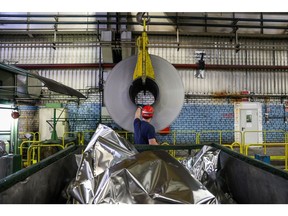Article content
(Bloomberg) — The world’s largest commodity traders are still making historically elevated profits, even as less-volatile markets mean their earnings have retreated from the bonanza that followed Russia’s full invasion of Ukraine.

The world’s largest commodity traders are still making historically elevated profits, even as less-volatile markets mean their earnings have retreated from the bonanza that followed Russia’s full invasion of Ukraine.

(Bloomberg) — The world’s largest commodity traders are still making historically elevated profits, even as less-volatile markets mean their earnings have retreated from the bonanza that followed Russia’s full invasion of Ukraine.
Article content
Article content
At the FT Commodities Global Summit in Lausanne this week, executives at the largest trading houses and their bankers indicated both on stage and privately that although earnings for 2024 and the first quarter of 2025 would be lower than the boom years of 2022-2023, they remained higher than almost any other time in history.
Advertisement 2
This advertisement has not loaded yet, but your article continues below.
THIS CONTENT IS RESERVED FOR SUBSCRIBERS ONLY
Subscribe now to read the latest news in your city and across Canada.
SUBSCRIBE TO UNLOCK MORE ARTICLES
Subscribe now to read the latest news in your city and across Canada.
REGISTER / SIGN IN TO UNLOCK MORE ARTICLES
Create an account or sign in to continue with your reading experience.
THIS ARTICLE IS FREE TO READ REGISTER TO UNLOCK.
Create an account or sign in to continue with your reading experience.
or
Article content
The trading houses are some of the world’s largest companies measured by annual turnover, but most are privately owned by founders and employees, and many don’t report their results publicly. The industry has enjoyed an enormous windfall since the invasion of Ukraine and the energy crisis that followed it, with combined profits of more than $50 billion in 2022 and 2023 at the four leading privately-owned energy traders — Vitol Group, Trafigura Group, Mercuria Energy Group Ltd. and Gunvor Group.
Commodity traders thrive on volatility and high prices, and both have retreated from the extremes of 2022. But the industry is still benefitting from disruptions to trade flows ranging from tariffs and sanctions to the crisis in the Red Sea, while the biggest players are also beginning to reap the rewards of billions of dollars invested in assets and diversification into new markets, helping to cushion the decline in trading profits.
Top Stories
Get the latest headlines, breaking news and columns.
By signing up you consent to receive the above newsletter from Postmedia Network Inc.
Thanks for signing up!
A welcome email is on its way. If you don’t see it, please check your junk folder.
The next issue of Top Stories will soon be in your inbox.
We encountered an issue signing you up. Please try again
Article content
Advertisement 3
This advertisement has not loaded yet, but your article continues below.
Article content
Vitol’s profit for 2024 was lower than the previous year’s level of $13.2 billion, but not drastically so, according to people briefed on the results, who asked not to be identified because the information is not public.
Trafigura, which saw annual earnings peak above $7 billion in 2022-2023, is on track for net profit for the half year ending in March that’s roughly in line with the past two reporting periods, when it posted half-year profits of $1.5 billion and $1.3 billion, other people familiar with the matter said. The people cautioned that the company’s accounts have not yet been finalized and things could yet change.
At the conference this week, Trafigura Chief Financial Officer Stephan Jansma said that the company’s financial performance had “reached a new cruising altitude.”
Advertisement 4
This advertisement has not loaded yet, but your article continues below.
Article content
“That cruising altitude is significantly less than the two years which were very high profitability, but also it’s significantly higher than the profitability we had before the Covid period,” he said.
Mercuria sees its earnings stabilizing at an annual rate of about $1.5 billion to $2 billion, according to a person familiar with the matter. The company made $2.1 billion in its financial year ending September 2024, Bloomberg has reported previously. That is lower than record profits of $3 billion in 2022, but far higher than any annual profit before then. Until 2021, Mercuria had never made more than $1 billion in a year.
Mercuria, Trafigura and Vitol all declined to comment.
Gunvor took some losses in the oil market last year — including a bullish play in the North Sea crude market that went wrong — but will still report the fourth or fifth best result in its history for 2024, Chief Executive Officer Torbjörn Törnqvist said in an interview.
Advertisement 5
This advertisement has not loaded yet, but your article continues below.
Article content
Vitol expects that margins and profitability are resetting at a higher level than before the pandemic, but below the recent boom, CEO Russell Hardy said at the conference. Despite the torrent of news, commodity markets have become “more bounded,” he said.
“The world is changing,” Hardy said. “The rhetoric — sanctions, tariffs, et cetera — is higher, but the reality is the volatility is lower.”
The trading companies are handing a significant chunk of their giant profits to their own shareholders, while also investing in assets like power plants and oil refineries, and diversifying into new markets like metals.
“We’re now looking at five to 10 projects where the size of the ticket would be half a billion dollars or more,” Mercuria CEO Marco Dunand told the conference. “And that’s something we certainly could not afford to do without this extra profit.”
—With assistance from Alfred Cang.
Article content
Share this article in your social network